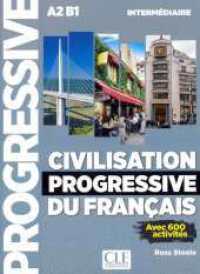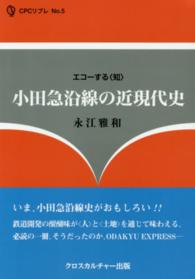Full Description
A book that has long been a standard for developmental physical education returns in a new, thoroughly updated edition with a sharpened focus on preparing tomorrow's physical educators to deliver developmentally appropriate lessons and activities for children in pre-K through grade 5.
Developmental Physical Education for All Children, now in its fifth edition and available in both print and e-book versions, takes a student-focused, comprehensive approach in preparing future teachers to create programs that enable children to gain the knowledge, skills, and dispositions vital to leading a physically active lifestyle.
This new edition is the first in more than a decade, with revisions and updates that make it like a brand-new book—one that maintains its solid foundations and instruction while equipping teachers for success in the 21st century.
How This Text Prepares Teachers
Developmental Physical Education for All Children, Fifth Edition, features the following benefits:
• Shows teachers how to translate child development theory and research from the psychomotor, cognitive, affective, and fitness domains into practice
• Offers teachers the understanding they need to create developmentally appropriate lessons that align with the new SHAPE America National Standards for Physical Education with grade-level outcomes, assessments, and instructions on implementing learning goals for students in pre-K through grade 5
• Provides multiple standards-based movement experiences for pre-K through grade 5 learners that include movement tasks and extensions, scaled learning environments, skill cues, practice strategies, teaching style choices, and formative assessments aligned with goals
• Supplies learning goal blueprints that integrate specialized skills, movement concepts, and tactics for developmental games, dance, and gymnastics
Content Overview
Future and current teachers will learn the research and theory behind this developmentally sound approach, which emphasizes movement skills and increased physical competence based on the developmental levels of pre-K through fifth-grade students. The first half of the book covers the learner, the movement content, the learning environment, and the instructional design; the second half provides detailed standards-based learning experiences, which are now organized by developmental level.
The concluding section offers two chapters on professionalism in the 21st century, giving teachers a conceptual framework to prepare and implement a developmental, standards-based scope and sequence for pre-K through grade 5 physical education and offering advice on staying current, being professionally involved, and advocating for comprehensive school physical activity.
Practical Ancillaries
Developmental Physical Education for All Children also provides a robust lineup of online ancillaries:
• A student web resource with reproducible forms that can be printed along with learning aids from the book and additional learning activities, some of which are enhanced by more than 20 video clips that demonstrate concepts in action
• An instructor guide that features in-class activities, answers to chapterr review questions, chapter overviews, and the "Big Ideas" from each chapter
• A test package featuring more than 445 questions from which teachers can create their own quizzes
• A presentation package offering more than 246 PowerPoint slides that highlight the key points while offering essential visual elements to augment understanding
Equipped to Provide High-Quality Education
The result of this comprehensive overhaul of a standard classic is that both future and current teachers will be prepared and equipped to provide high-quality developmental physical education that can help children be physically active now and throughout their lives.
Contents
Part I: The Learner
Chapter 1. Quality Developmental Physical Education
The Case for Quality Physical Education
Overview of Developmental Physical Education
Big Ideas
Chapter 2. The Healthy Child
Physical Activity
Fitness Education
Nutrition Education
Big Ideas
Chapter 3. The Thinking, Feeling, and Socializing Child
The Thinking Child
The Feeling and Socializing Child
Teaching Personal and Social Responsibility
Big Ideas
Chapter 4. The Moving Child
Motor Development and Motor Learning
The Process of Learning
Perceptual-Motor Development
Phases and Stages of Motor Skill Development
Learning New Movement Skills
Making Connections
Big Ideas
Part II: Movement Content and Learning Environment
Chapter 5. The Movement Framework
Rationale for the Movement Framework
Movement Content
Movement Concepts
Putting it All Together
Big Ideas
Chapter 6. The Environment and the Task
The Environment
The Task
Making Connections
Building Movement Task Progressions
Big Ideas
Chapter 7. Designing Movement Skill Practice
Focusing Practice
Classifying Practice
Feedback
Big Ideas
Part III: Instructional Design
Chapter 8. Standards-Based Physical Education
Development of Standards, Outcomes, and Guidelines
National Standards and Outcomes for Physical Education
Unpacking Standards
Guidelines for Preschool Children
Alignment Charts
Big Ideas
Chapter 9. Assessing Student Learning
Understanding Assessment
What to Assess
How to Assess
When to Assess
Grading
Big Ideas
Chapter 10. Effective Teaching: Designing and Implementing Learning Experiences
Choosing Movement Activities
Choosing Practice Conditions and Feedback
Choosing Instructional Strategies
Reproduction Cluster
Production Cluster
Mobility Ability
Universal Design for Learning
Homework
Big Ideas
Chapter 11. Diverse Learners
Marjorie Ellis
What's in a Name?
Differentiated Instruction
Impact of Federal Laws on Physical Education for Students With Disability
Categories of Disability, Characteristics, and Needs
Dimensions of Diversity
Big Ideas
Chapter 12. Classroom Management
Teaching Personal and Social Responsibility
Positive Teacher Attributes
The Social Contract
The Physical Environment
Establishing Developmentally Appropriate Protocols
Effective Management Practices
Big Ideas
Part IV: Standards-Based Learning Experiences for Pre-K Through Grade 2
Chapter 13. Designing Learning Experiences for Pre-K Students
Development of Pre-K Learners
Designing Instruction
Assessing Learning
Providing Feedback
Activities to Reinforce Personal and Social Responsibility
Movement Activities
Chapter 14. Designing Learning Experiences for K-2 Students
Standards-Based Learning
Assessing Learning
Designing Instruction
Practice and Feedback
Activities to Reinforce Personal and Social Responsibility
Chapter 15. K-2 Learning Experiences for Locomotor Skills
Traveling
Flight
Chapter 16. K-2 Learning Experiences for Stability Skills
Balance
Rolling
Step-Like Actions
Chapter 17. K-2 Learning Experiences for Manipulative Skills
Throwing
Catching
Rolling
Kicking and Dribblin
Bouncing
Strikes With Body Parts
Striking With Paddles
Striking With Bats and Polo Sticks
Part V: Standards-Based Learning Experiences for Grades 3 Through 5
Chapter 18. Designing Learning Experiences for Grades 3 Through 5
Development of Learners in Grades 3 Through 5
Standards-Based Learning
Assessing Learning
Designing Instruction
Practice and Feedback
Activities to Reinforce Personal and Social Responsibility
Chapter 19. Developmental Games
Developmentally Appropriate Games
Best Practices When Teaching Games
Game Classification
Designing Instruction
Big Ideas
Target Games: Combination Level
Target Games: Application Level
Striking and Fielding Games: Combination Level
Striking and Fielding Games: Application Level
Net and Wall Games: Combination Level
Net and Wall Games: Application Level
Invasion Games: Combination Level
Invasion Games: Application Level
Chapter 20. Developmental Dance
Movement Framework for Developmental Dance
The Role of Dance in Physical Education
Outcomes of Developmental Dance
Rhythmic Fundamentals and the Elements of Rhythm
Dance and the Spectrum of Teaching Styles
Developmental Progression for Teaching Creative Dance
Designing Instruction for Developmental Dance
Big Ideas
Learning Experiences for Developmental Dance: Combination Level
Learning Experiences for Developmental Dance: Application Level
Chapter 21. Developmental Gymnastics
Movement Framework for Developmental Gymnastics
Best Practices When Teaching Gymnastics
Designing Instruction for Developmental Gymnastics
Big Ideas
Combination-Level Task Progressions
Application-Level Task Progressions
Chapter 22. Fitness Education for Grades 3 Through 5
Debra Ballinger
FITT Guidelines
Exercise Principles
Skill-Related Fitness Development
Best Practices for Fitness Education
Fitness Assessment
Fitness Education Programs
Enhancing Physical Activity and Fitness With Technology
Designing Instruction
Big Ideas
Exercise Glossary
Part VI: Professional Development
Chapter 23. Developmental Physical Education Curriculum
Steps in Curriculum Planning
Comprehensive School Physical Activity Program
Big Ideas
Chapter 24. Professionalism, Leadership, and Advocacy
Professional Standards
Big Ideas







